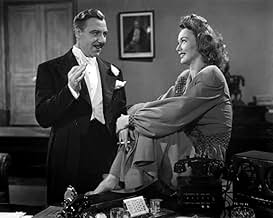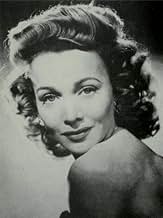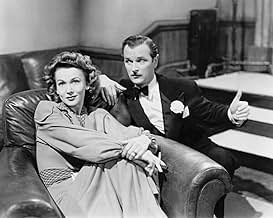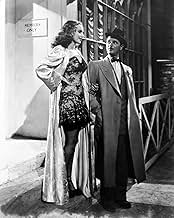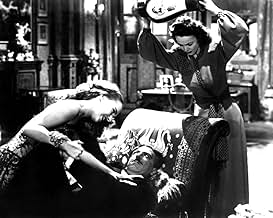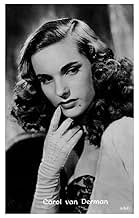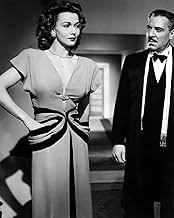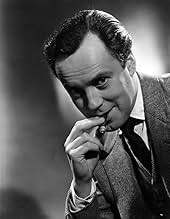Aggiungi una trama nella tua linguaIn post- WW2 Britain, an American fashion journalist, her ex-army fiancé, and a gang of honest toughs from a local gym attempt to bring black market organized crime to justice.In post- WW2 Britain, an American fashion journalist, her ex-army fiancé, and a gang of honest toughs from a local gym attempt to bring black market organized crime to justice.In post- WW2 Britain, an American fashion journalist, her ex-army fiancé, and a gang of honest toughs from a local gym attempt to bring black market organized crime to justice.
Carol van Derman
- Mercia Lane
- (as Carol Van Derman)
Recensioni in evidenza
Edmond Greville brought a gallic sensibility to this vivid evocation of the postwar days when Soho was a byword for criminality and vice, fluidly photographed by Hone Glendinning and ending in a slam-bang finale.
Obligatory American imports Joseph Calleia and Carole Landis both give excellent accounts of themselves as "the nastiest thug in Europe" and his nemesis "the best fashion editor in the business". A uniformly memorable supporting cast include Nigel Patrick in full-on spiv mode, John Salew as Patrick's perspiring courier rejoicing in the name 'Greasy', and Hay Petrie in his creepiest role since he played Quilp as a murderous henchman known only as 'The Barber'.
Obligatory American imports Joseph Calleia and Carole Landis both give excellent accounts of themselves as "the nastiest thug in Europe" and his nemesis "the best fashion editor in the business". A uniformly memorable supporting cast include Nigel Patrick in full-on spiv mode, John Salew as Patrick's perspiring courier rejoicing in the name 'Greasy', and Hay Petrie in his creepiest role since he played Quilp as a murderous henchman known only as 'The Barber'.
Although visiting American actress Carole Landis gets top billing in the 1948 British crime thriller, "The Silk Noose" (AKA "The Noose"), it's the much underrated English actor, Nigel Patrick ("The League of Gentlemen," "The Sound Barrier," "Raintree County") who steals this movie.
From his very first appearance yelping cheerful insults into a telephone, Nigel Patrick takes command of this unusual British crime feature, as a flip and glib Cockney gangster who is part conniving Phil Silvers (think "Sgt. Bilko"), part sleazy Michael Palin (think suavely snide East End hoodlum Luigi Vercotti in "Monty Python"), and part fast-talking James Cagney (think "One, Two, Three") .
So wacky and so unexpected and so hilarious is Patrick's maniacal insincerity that you may drum your fingers impatiently during the few scenes that he's not on camera being cheerfully devious -- however action-packed some of those scenes may be. (There is considerable action in "The Silk Noose," some of it nail-biting -- this, after all, is a near-noir crime story with an alarming body count -- but on the whole it's comic-book roughhousing, best captioned by "Pow!" " Bam!" and "Oomph!")
Written by Richard Llewellyn ("How Green Was My Valley," "None But the Lonely Heart"), "The Silk Noose" homes in on "spivs," British racketeers of the late 1940s , grown fat on wartime black market profits, and now still doing their bit for Britain by blithely counterfeiting, smuggling, and, for all we know, loitering and littering. (It may take you back to Jules Dassin's more earnest, better-known "Night and the City," with Richard Widmark, which came along two years later.)
In this particular case, the local don, Sugiani (Joseph Calleia), prefers to perform his perfidy out of a posh Soho nightclub that features très chic chanteuses and très cher champagne. Looking like a Satanic Cesar Romero, Maltese-American actor Joseph Calleia cheerfully overacts, shaking his part until it cries "Basta!" Both sinister and jovial at the same time, Calleia's gangster could be seen as a stand-in for Mussolini – posturing, threatening and begging for adoration simultaneously.
Make no mistake, for all his charm and over-the-top grand opera posturing, Sugiani can be a very dangerous man, particularly when issuing orders to his very own Heinrich Himmler, a spine-chilling personal assassin known as "Barber" (the great Dickensian character actor, Hay Petrie), an unctuous, leering Claude Rains-clone who scuttles around a bleak London like a human cockroach, using a silk stocking ("the noose") as his preferred means of dispatch.
Nigel Patrick's Bar Gorman is Sugiani's right-hand man and/or partner. He could also be a stand-in for Nazi propaganda minister Joseph Goebbels, particularly when barking orders over his huge desktop intercom or trying to wheedle favorable newspaper publicity. The relationship of the two crooks is complicated, and at times the two suddenly snarl at each other like strange dogs passing on the street, then as quickly make up. It's an insane partnership made in Hell, and the two men, continuously on edge, are a fascinating team, blending affinity, iniquity and irrationality.
Into this hidey-hole of Axis-style moray eels merrily steps the Dior-dressed figure of Carole Landis, an American fashion editor working for a London newspaper (don't ask). Dressed to the nines in every shot, Landis, as a brash and beautiful career girl, puts across a delightful sassiness as she investigates a grisly London murder that isn't getting the attention she feels it deserves.
As expected, the trail leads to the bad, bad Sugiani, but, surrounded by his thuggish hirelings, he's apparently invulnerable. However, in a twist reminiscent of the creepy Peter Lorre classic, "M", the muscle-bound laborers of London's docks and markets are enrolled in a vigilante lynch mob, the lumpenproletariat out to take back their streets, and a rousing if unconvincing version of class warfare breaks out as the forces of Good, wearing football jerseys, battle the forces of Evil, in dinner jackets.
With all this, "The Silk Noose" would still be just another dated British "spiv" movie -- though with a few comedic grace notes -- but for Nigel Patrick's virtuoso performance and these three significant particulars :
1. Stanley Holloway, the beloved Alfred P. Doolittle of "My Fair Lady," plays a very well-dressed Scotland Yard inspector who may be on the take, and does it up well. He has a surprisingly commanding presence as a top cop and uses his authoritative voice to get your attention and hold it.
2. The director was Edmond Gréville, who had apprenticed with the legendary Frenchman Abel Gance ("Napoleon") . Besides pacing the movie with fast rhythmic editing, he offers up a boutique of superimposed images, extreme close-ups, artistic camera angles and surprising staging, so you don't dare blink for missing some exciting shot or experimental exposure. (For instance, he shoots one nightclub scene through the multifaceted glass top of a perfume bottle -- giving it the vertiginous viewpoint of a drunken housefly.) There's also an unexpected degree of eroticism, which marked many of the films of this half-French half-British director.
3. "The Silk Noose" was to be the next-to-the-last movie of the tragic Carole Landis, who had died by the time of the film's release in August 1948. A delightful actress with unrealized potential, she had worn herself out with endless USO tours: she had traveled more than 100,000 miles during the war, had spent more time visiting troops than any other actress, and had even caught a nasty case of malaria. By the time she killed herself at the age of 29, she had been married five times. Under still mysterious circumstances, her body was discovered by her married boyfriend, actor Rex Harrison , who, almost two decades later, was to appear with Stanley Holloway in " My Fair Lady", a triumph for them both.
From his very first appearance yelping cheerful insults into a telephone, Nigel Patrick takes command of this unusual British crime feature, as a flip and glib Cockney gangster who is part conniving Phil Silvers (think "Sgt. Bilko"), part sleazy Michael Palin (think suavely snide East End hoodlum Luigi Vercotti in "Monty Python"), and part fast-talking James Cagney (think "One, Two, Three") .
So wacky and so unexpected and so hilarious is Patrick's maniacal insincerity that you may drum your fingers impatiently during the few scenes that he's not on camera being cheerfully devious -- however action-packed some of those scenes may be. (There is considerable action in "The Silk Noose," some of it nail-biting -- this, after all, is a near-noir crime story with an alarming body count -- but on the whole it's comic-book roughhousing, best captioned by "Pow!" " Bam!" and "Oomph!")
Written by Richard Llewellyn ("How Green Was My Valley," "None But the Lonely Heart"), "The Silk Noose" homes in on "spivs," British racketeers of the late 1940s , grown fat on wartime black market profits, and now still doing their bit for Britain by blithely counterfeiting, smuggling, and, for all we know, loitering and littering. (It may take you back to Jules Dassin's more earnest, better-known "Night and the City," with Richard Widmark, which came along two years later.)
In this particular case, the local don, Sugiani (Joseph Calleia), prefers to perform his perfidy out of a posh Soho nightclub that features très chic chanteuses and très cher champagne. Looking like a Satanic Cesar Romero, Maltese-American actor Joseph Calleia cheerfully overacts, shaking his part until it cries "Basta!" Both sinister and jovial at the same time, Calleia's gangster could be seen as a stand-in for Mussolini – posturing, threatening and begging for adoration simultaneously.
Make no mistake, for all his charm and over-the-top grand opera posturing, Sugiani can be a very dangerous man, particularly when issuing orders to his very own Heinrich Himmler, a spine-chilling personal assassin known as "Barber" (the great Dickensian character actor, Hay Petrie), an unctuous, leering Claude Rains-clone who scuttles around a bleak London like a human cockroach, using a silk stocking ("the noose") as his preferred means of dispatch.
Nigel Patrick's Bar Gorman is Sugiani's right-hand man and/or partner. He could also be a stand-in for Nazi propaganda minister Joseph Goebbels, particularly when barking orders over his huge desktop intercom or trying to wheedle favorable newspaper publicity. The relationship of the two crooks is complicated, and at times the two suddenly snarl at each other like strange dogs passing on the street, then as quickly make up. It's an insane partnership made in Hell, and the two men, continuously on edge, are a fascinating team, blending affinity, iniquity and irrationality.
Into this hidey-hole of Axis-style moray eels merrily steps the Dior-dressed figure of Carole Landis, an American fashion editor working for a London newspaper (don't ask). Dressed to the nines in every shot, Landis, as a brash and beautiful career girl, puts across a delightful sassiness as she investigates a grisly London murder that isn't getting the attention she feels it deserves.
As expected, the trail leads to the bad, bad Sugiani, but, surrounded by his thuggish hirelings, he's apparently invulnerable. However, in a twist reminiscent of the creepy Peter Lorre classic, "M", the muscle-bound laborers of London's docks and markets are enrolled in a vigilante lynch mob, the lumpenproletariat out to take back their streets, and a rousing if unconvincing version of class warfare breaks out as the forces of Good, wearing football jerseys, battle the forces of Evil, in dinner jackets.
With all this, "The Silk Noose" would still be just another dated British "spiv" movie -- though with a few comedic grace notes -- but for Nigel Patrick's virtuoso performance and these three significant particulars :
1. Stanley Holloway, the beloved Alfred P. Doolittle of "My Fair Lady," plays a very well-dressed Scotland Yard inspector who may be on the take, and does it up well. He has a surprisingly commanding presence as a top cop and uses his authoritative voice to get your attention and hold it.
2. The director was Edmond Gréville, who had apprenticed with the legendary Frenchman Abel Gance ("Napoleon") . Besides pacing the movie with fast rhythmic editing, he offers up a boutique of superimposed images, extreme close-ups, artistic camera angles and surprising staging, so you don't dare blink for missing some exciting shot or experimental exposure. (For instance, he shoots one nightclub scene through the multifaceted glass top of a perfume bottle -- giving it the vertiginous viewpoint of a drunken housefly.) There's also an unexpected degree of eroticism, which marked many of the films of this half-French half-British director.
3. "The Silk Noose" was to be the next-to-the-last movie of the tragic Carole Landis, who had died by the time of the film's release in August 1948. A delightful actress with unrealized potential, she had worn herself out with endless USO tours: she had traveled more than 100,000 miles during the war, had spent more time visiting troops than any other actress, and had even caught a nasty case of malaria. By the time she killed herself at the age of 29, she had been married five times. Under still mysterious circumstances, her body was discovered by her married boyfriend, actor Rex Harrison , who, almost two decades later, was to appear with Stanley Holloway in " My Fair Lady", a triumph for them both.
American journalist Linda Medbury may be on the staff of a London newspaper to cover the fashion column but this is not going to stop her covering other stories that she comes across. However when she gets onto the extensive racket run by Sugiani, nobody can convince her of the plain and simple fate that has come to anyone who has gone toe-to-toe with his operation. So while Linda continues to work to expose Sugiani for who he is, her military boyfriend Captain "Jumbo" Hyde gathers many men as he can from his associates to protect her in place of a police force defeated before they begin by corruption.
This summer the BBC delivered a season of British films and, to their credit it was not the usual parade of Dam Busters, Zulu and other Bank Holiday favourites but rather an interesting mix of films that are rarely seen. With 26 votes to its name on this site, it is perhaps fair to say that The Noose was one of these. The style of the film is a bit mixed. At times it appears to be every inch a British version of the American gangster film but then at others it is more of a comedy with cheeky chappy clichés kicking around in the shadows. As a result it doesn't totally hang together and I found myself distracted and my interest broken up by the inconsistent tone.
However it is still of interest and does have scenes of value. We do get moments that are easily comparable with the strongest from American noir and we do get amusing characters that remind us where we are but again, these things seem to be working against one another. Gréville's direction is good in regards working with his cinematographer but in terms of solving the issues over the narrative flow, he cannot. Nor can the cast either, and many of them seem to be in different films unfortunately. Landis is enjoyable in the lead she has what the experts would call "spunk" and it brought a bit of spark to the film. Farr is no more than serviceable and sadly the film sags when he is the focus. Calleia is a solid villain but the problem is that he isn't playing it straight and tough and he has an air of flamboyance about him. There is nothing wrong with him in this regard it is just that, within this film it is Nigel Patrick that dominates that sort of area with a wonderfully comic caricature that he works well.
An interesting film to see then for its attempts to do what it does within a British context but it is the inability to either hold a consistent tone or blend the different ones successfully that sees it be a lesser film than I would have hoped. I would have liked to be able to praise it on account of it being obscure and thus me looking cool but as it is it is interesting but not all that great.
This summer the BBC delivered a season of British films and, to their credit it was not the usual parade of Dam Busters, Zulu and other Bank Holiday favourites but rather an interesting mix of films that are rarely seen. With 26 votes to its name on this site, it is perhaps fair to say that The Noose was one of these. The style of the film is a bit mixed. At times it appears to be every inch a British version of the American gangster film but then at others it is more of a comedy with cheeky chappy clichés kicking around in the shadows. As a result it doesn't totally hang together and I found myself distracted and my interest broken up by the inconsistent tone.
However it is still of interest and does have scenes of value. We do get moments that are easily comparable with the strongest from American noir and we do get amusing characters that remind us where we are but again, these things seem to be working against one another. Gréville's direction is good in regards working with his cinematographer but in terms of solving the issues over the narrative flow, he cannot. Nor can the cast either, and many of them seem to be in different films unfortunately. Landis is enjoyable in the lead she has what the experts would call "spunk" and it brought a bit of spark to the film. Farr is no more than serviceable and sadly the film sags when he is the focus. Calleia is a solid villain but the problem is that he isn't playing it straight and tough and he has an air of flamboyance about him. There is nothing wrong with him in this regard it is just that, within this film it is Nigel Patrick that dominates that sort of area with a wonderfully comic caricature that he works well.
An interesting film to see then for its attempts to do what it does within a British context but it is the inability to either hold a consistent tone or blend the different ones successfully that sees it be a lesser film than I would have hoped. I would have liked to be able to praise it on account of it being obscure and thus me looking cool but as it is it is interesting but not all that great.
The Silk Noose, or Noose, as it is also known, from 1948 is a British film starring Carole Landis as a fashion writer for a newspaper.
It's post-war Britain, and despite the war being over, there are many items that are hard to get. An Italian black market racketeer, Sugiani (Calleia) runs an operation in black market goods. So far, the police haven't been able to get them.
A fashion writer, Linda Medbury (Landis), is determined to bring down the gang, although her publisher would rather she stick to clothes. The front for the group, The Blue Moon Club, winds up with a corpse, which sends Linda's reporter tentacles high.
Linda finds herself in danger as does her source. Her fiance is determined to protect her and bring down Sugiani at the same time. It won't be easy.
Sometimes this film seemed like a comedy, particularly with the rapid fire dialogue of Nigel Patrick as a cohort of Sugiani's, and a woman losing her dress toward the end of the film. The last twenty or so minutes has a lot of action.
This was the beautiful Landis' second-last film. What a waste of talent. She gives a vivacious, likeable performance here. Unfortunately, her career fell on hard times when she ended her relationship with Darryl F. Zanuck. Unhappy with her career and misguided in her search for love, she committed suicide. Life in Hollywood for a woman was always extremely difficult, and she was one of its victims.
It's post-war Britain, and despite the war being over, there are many items that are hard to get. An Italian black market racketeer, Sugiani (Calleia) runs an operation in black market goods. So far, the police haven't been able to get them.
A fashion writer, Linda Medbury (Landis), is determined to bring down the gang, although her publisher would rather she stick to clothes. The front for the group, The Blue Moon Club, winds up with a corpse, which sends Linda's reporter tentacles high.
Linda finds herself in danger as does her source. Her fiance is determined to protect her and bring down Sugiani at the same time. It won't be easy.
Sometimes this film seemed like a comedy, particularly with the rapid fire dialogue of Nigel Patrick as a cohort of Sugiani's, and a woman losing her dress toward the end of the film. The last twenty or so minutes has a lot of action.
This was the beautiful Landis' second-last film. What a waste of talent. She gives a vivacious, likeable performance here. Unfortunately, her career fell on hard times when she ended her relationship with Darryl F. Zanuck. Unhappy with her career and misguided in her search for love, she committed suicide. Life in Hollywood for a woman was always extremely difficult, and she was one of its victims.
Tangy post-War British 'Spiv' movie (a cycle of films with roots in 30s American Gangster movies, featuring characters profiting from wartime rationing in a similar fashion to 30s bootleggers, but not so clearly glamorised as their Stateside equivalents). Directed by Edmond T. Greville (BEAT GIRL aka WILD FOR KICKS), and adapted from a stage play, this features Carole Landis (in one of her final roles) as nosy reporter Linda Medbury who, together with her ex-commando boyfriend Jumbo Hoyle (played by Derek Farr), gets on the trail of a gang of post-war black marketeers headed by Soho nightclub owner Sugiani, played by Joseph Calleia (whose role was based on a real-life Post-war London criminal). This gets them mixed up with London 'Spiv' Bar Gorman, played by Nigel Patrick, whose slangy, comic performance almost overshadows the surrounding film. Imaginatively shot, speedily paced, and ripe with post-War vernacular and the requisite criminal dust-ups (primarily involving the good guys' recruited gang of boxers, market porters, and cab drivers versus the low-life criminals), this is an entertaining slice of British crime and deserves to be better known, as it's worthy of a place alongside such noted post-War British crime movies as BRIGHTON ROCK and NIGHT AND THE CITY. Check it out, if you get the chance.
Lo sapevi?
- Quiz"Noose" was filmed in England during January and February of 1948. This was the final movie Carole Landis made before her death.
- ConnessioniFeatured in Voyage à travers le cinéma français (2016)
- Colonne sonoreWhen Love Has Passed You By
Composed by Edward Dryhurst
Lyrics by Barry Gray and Jean Cavall
Performed by Olive Lucius (uncredited)
I più visti
Accedi per valutare e creare un elenco di titoli salvati per ottenere consigli personalizzati
Dettagli
- Data di uscita
- Paese di origine
- Lingue
- Celebre anche come
- The Silk Noose
- Luoghi delle riprese
- Warner Brothers First National Studios, Teddington Studios, Teddington, Middlesex, Inghilterra, Regno Unito(studio: made at Warner Bros. First National Studios, Teddington, England.)
- Aziende produttrici
- Vedi altri crediti dell’azienda su IMDbPro
- Tempo di esecuzione1 ora 16 minuti
- Colore
- Proporzioni
- 1.37 : 1
Contribuisci a questa pagina
Suggerisci una modifica o aggiungi i contenuti mancanti

Divario superiore
By what name was Nodo scorsoio (1948) officially released in Canada in English?
Rispondi
